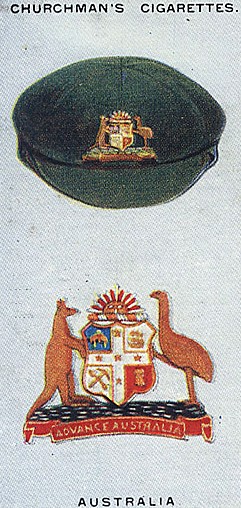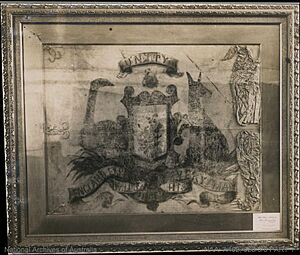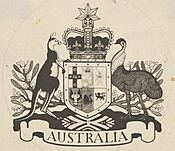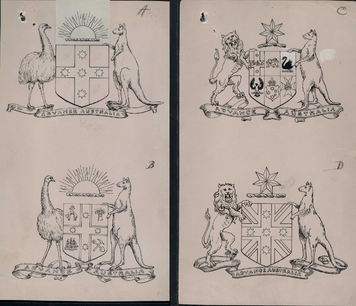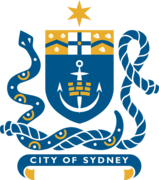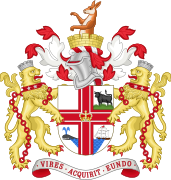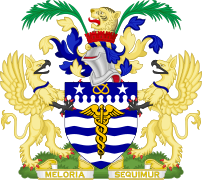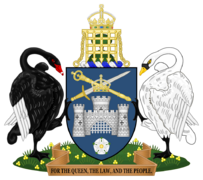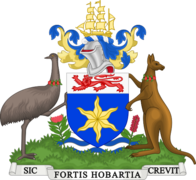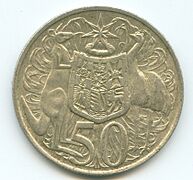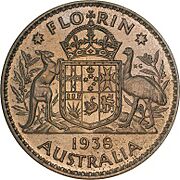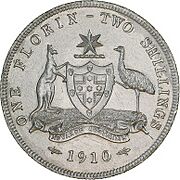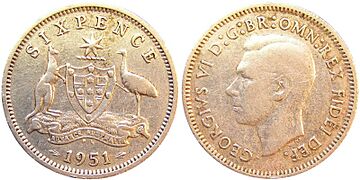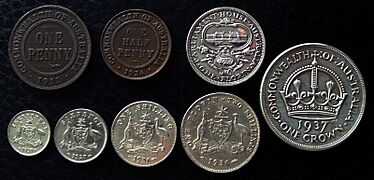Coat of arms of Australia facts for kids
Quick facts for kids Commonwealth Coat of Arms |
|
|---|---|
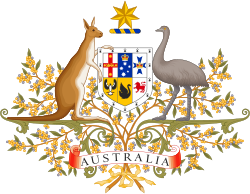 |
|
| Versions | |
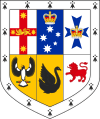
Shield-only version
|
|
| Armiger | Commonwealth of Australia |
| Adopted | 19 September 1912 |
| Crest | The Commonwealth Star: A seven-pointed star, gold |
| Torse | Gold and blue |
| Blazon | see below |
| Supporters | Left a red kangaroo, right an emu, both in their natural colours |
| Compartment | none, golden wattle is depicted in commonly used versions |
| Motto | none, the name of the country is written on a scroll in commonly used versions |
The Coat of Arms of Australia, officially called the Commonwealth Coat of Arms, is an important national symbol for Australia. It shows a shield with symbols from Australia's six states. Two native Australian animals, the kangaroo and the emu, hold up this shield.
Above the shield, a seven-pointed Commonwealth Star represents the states and territories. Below the shield, you can often see golden wattle, which is Australia's national floral emblem.
The first version of the Coat of Arms was approved by King Edward VII in 1908. The current design was approved by King George V on September 19, 1912. Even after the new design, the 1908 version was still used sometimes, like on the back of the old sixpenny coin.
Contents
What the Coat of Arms Looks Like
The Main Shield
The main part of the Coat of Arms is the shield, also called the escutcheon. It is divided into six sections, one for each Australian state.
The shield has a special border around it, called an ermine border. This border helps show that the shield is one complete symbol, not just a collection of separate state badges. It also represents the authority of the Australian crown.
In the top row of the shield, from left to right, you'll find symbols for New South Wales, Victoria, and Queensland. In the bottom row, from left to right, are symbols for South Australia, Western Australia, and Tasmania.
The Commonwealth Star
Above the shield is the seven-pointed Commonwealth Star. It's also known as the Star of Federation. This star sits on a blue and gold wreath, which forms the crest.
Six of the star's points stand for the original six states of Australia. The seventh point represents all of Australia's territories.
The Animal Supporters
The red kangaroo and emu stand on either side of the shield, holding it up. These animals are special because they are only found in Australia. They were likely chosen because they are large and well-known native animals.
They also symbolise progress and moving forward. This is because neither animal can easily walk backwards.
The Background Details
Behind the shield, you'll often see a wreath of golden wattle. This is Australia's official national floral emblem. However, the way it's drawn isn't always exactly like the real plant.
At the very bottom, there's usually a scroll with the word "Australia" written on it. While the golden wattle and the scroll are almost always shown, they are technically extra artistic touches. They are not part of the official description of the Coat of Arms.
| State | Badge | Description |
|---|---|---|
| New South Wales |  |
The cross of St. George with a lion and stars. |
| Victoria |  |
St Edward's Crown and the Southern Cross stars. |
| Queensland |  |
A blue Maltese cross and St Edward's Crown. |
| South Australia |  |
The Australian piping shrike bird. |
| Western Australia |  |
A black swan. |
| Tasmania |  |
A red lion walking. |
History of the Coat of Arms
| Commonwealth Coat of Arms 1908–1912 | |
|---|---|
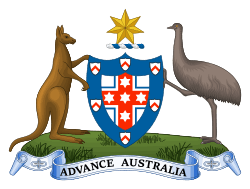 |
|
| Adopted | 7 May 1908 |
| Relinquished | 19 September 1912 |
| Crest | Commonwealth Star |
| Torse | White and blue |
| Blazon | Azure on an Inescutcheon Argent upon a Cross of St. George cottised of the field five six pointed Stars of the second (representing the Constellation of the Southern Cross) all within an Orle of Inescutcheons of the second, each charged with a Chevron Gules |
| Supporters | Red kangaroo and emu, both proper |
| Compartment | Grassy field proper |
| Motto | Advance Australia |
Before Australia became a federation, an unofficial coat of arms was used. It had a shield with symbols of trade, like a golden fleece and wheat. A kangaroo and emu supported it, and the motto was "Advance Australia." This design was popular in the eastern colonies.
After the federation of Australia in 1901, the first official Coat of Arms was designed by Wilson Dobbs. King Edward VII approved it on May 7, 1908.
This first design had a shield with a white background and a red St George's Cross. It also had blue lines and a blue border with six smaller shields, each with a red chevron. The seven-pointed star was above the shield. A kangaroo and an emu supported the shield, standing on grass. The motto "Advance Australia" was on a scroll.
This 1908 Coat of Arms was used by the government. It appeared on Australian coins like the sixpence from 1910 to 1963.
The 1908 design caused some debate. Some people felt it didn't represent all the different backgrounds of settlers from the British Isles. They wanted symbols for Scottish and Irish heritage too.
Because of these concerns, the Coat of Arms was redesigned in 1911 by William Gullick. King George V officially approved this new design on September 19, 1912.
The new design kept the kangaroo and emu as supporters, but they looked more realistic. To show each state individually, the shield now featured each state's heraldic badge. The ermine border was added, which was a feature from Scottish heraldry, helping to address earlier criticisms.
The new Coat of Arms also removed the grass beneath the shield. The scroll simply read "Australia." The colours of the wreath changed from blue and white to blue and gold. Two sprays of golden wattle were added in the background. While the wattle isn't officially part of the Coat of Arms description, it was later made Australia's national flower in 1988.
In the 1950s, there were ideas to redesign the Coat of Arms again. Some wanted to add a crown or remove the golden wattle to make it easier to reproduce. There was also a suggestion to make it look more like the Canadian royal arms, to show Australia's growing independence. However, no major changes were made.
How the Coat of Arms is Used
The Commonwealth Coat of Arms is a formal symbol of Australia. It shows the authority of the Australian government.
Australian Government departments, agencies, and courts use the Arms. Members of the Australian Parliament can also use it in their official duties.
It's important that the Coat of Arms is not used in a way that suggests the government officially supports or guarantees something. Private citizens or organisations usually need special permission to use it. However, it is sometimes allowed for things like sporting teams or educational books. For example, you can see the Arms on the uniforms of the Australian Olympic team.
Using the Coat of Arms without permission can be against the law.
The Coat of Arms has appeared on Australian coins since the early 1900s. The 1908 version was on many silver coins until 1936. After 1936, the current Coat of Arms appeared on the Florin coin. Since 1966, the current Coat of Arms has been on the 50-cent coin.
The Coat of Arms is also used as a badge of rank for senior military officers in the Army, Navy, and Air Force.
Sometimes, people jokingly say that Australians are the only people who eat the animals on their Coat of Arms. A dish combining kangaroo and emu meat is even called "Coat of Arms."
State and Territory Coats of Arms
 |
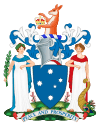 |
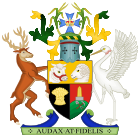 |
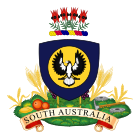 |
| New South Wales | Victoria | Queensland | South Australia |
|---|---|---|---|
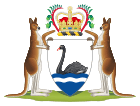 |
 |
 |
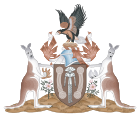 |
| Western Australia | Tasmania | Australian Capital Territory | Northern Territory |
City Coats of Arms
Coins with the Coat of Arms
-
1966 round 50 cent coin
-
Post-1936 Australian Florin (2 shillings)
-
Pre-1936 Australian Florin (2 shillings)
-
Australian sixpence (6 pence)
-
Pre-1936 coins of the Australian pound
See also
 In Spanish: Escudo de Australia para niños
In Spanish: Escudo de Australia para niños
- Flag of Australia
- National colours of Australia
- Australian heraldry


